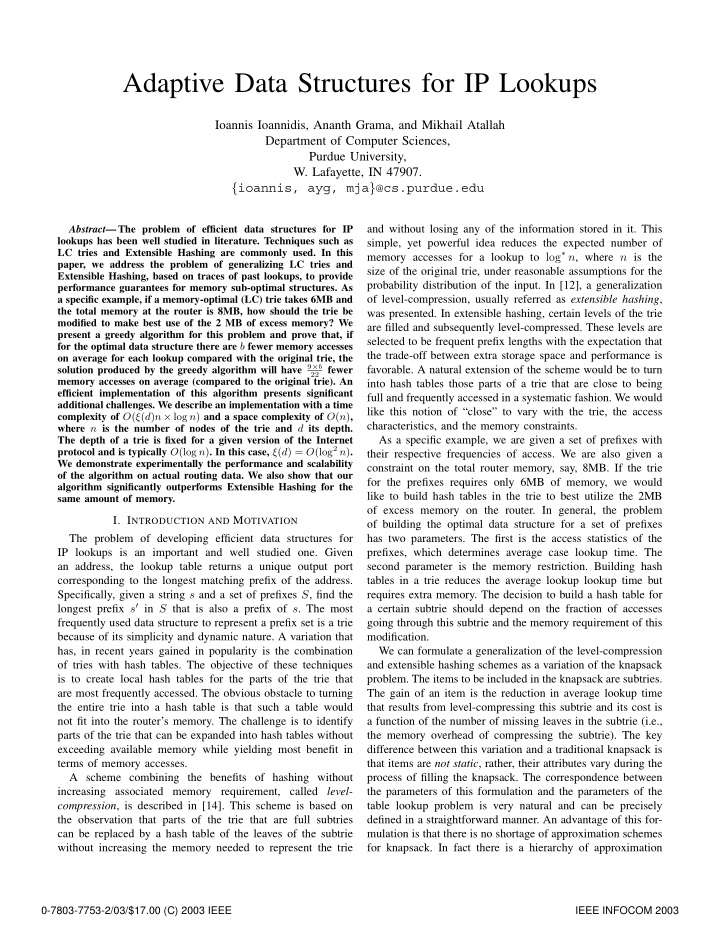



Adaptive Data Structures for IP Lookups Ioannis Ioannidis, Ananth Grama, and Mikhail Atallah Department of Computer Sciences, Purdue University, W. Lafayette, IN 47907. { ioannis, ayg, mja } @cs.purdue.edu and without losing any of the information stored in it. This Abstract — The problem of efficient data structures for IP lookups has been well studied in literature. Techniques such as simple, yet powerful idea reduces the expected number of memory accesses for a lookup to log ∗ n , where n is the LC tries and Extensible Hashing are commonly used. In this paper, we address the problem of generalizing LC tries and size of the original trie, under reasonable assumptions for the Extensible Hashing, based on traces of past lookups, to provide probability distribution of the input. In [12], a generalization performance guarantees for memory sub-optimal structures. As of level-compression, usually referred as extensible hashing , a specific example, if a memory-optimal (LC) trie takes 6MB and the total memory at the router is 8MB, how should the trie be was presented. In extensible hashing, certain levels of the trie modified to make best use of the 2 MB of excess memory? We are filled and subsequently level-compressed. These levels are present a greedy algorithm for this problem and prove that, if selected to be frequent prefix lengths with the expectation that for the optimal data structure there are b fewer memory accesses the trade-off between extra storage space and performance is on average for each lookup compared with the original trie, the solution produced by the greedy algorithm will have 9 × b fewer favorable. A natural extension of the scheme would be to turn 22 memory accesses on average (compared to the original trie). An into hash tables those parts of a trie that are close to being efficient implementation of this algorithm presents significant full and frequently accessed in a systematic fashion. We would additional challenges. We describe an implementation with a time like this notion of “close” to vary with the trie, the access complexity of O ( ξ ( d ) n × log n ) and a space complexity of O ( n ) , characteristics, and the memory constraints. where n is the number of nodes of the trie and d its depth. The depth of a trie is fixed for a given version of the Internet As a specific example, we are given a set of prefixes with protocol and is typically O (log n ) . In this case, ξ ( d ) = O (log 2 n ) . their respective frequencies of access. We are also given a We demonstrate experimentally the performance and scalability constraint on the total router memory, say, 8MB. If the trie of the algorithm on actual routing data. We also show that our for the prefixes requires only 6MB of memory, we would algorithm significantly outperforms Extensible Hashing for the like to build hash tables in the trie to best utilize the 2MB same amount of memory. of excess memory on the router. In general, the problem I. I NTRODUCTION AND M OTIVATION of building the optimal data structure for a set of prefixes The problem of developing efficient data structures for has two parameters. The first is the access statistics of the IP lookups is an important and well studied one. Given prefixes, which determines average case lookup time. The an address, the lookup table returns a unique output port second parameter is the memory restriction. Building hash corresponding to the longest matching prefix of the address. tables in a trie reduces the average lookup lookup time but Specifically, given a string s and a set of prefixes S , find the requires extra memory. The decision to build a hash table for longest prefix s ′ in S that is also a prefix of s . The most a certain subtrie should depend on the fraction of accesses frequently used data structure to represent a prefix set is a trie going through this subtrie and the memory requirement of this because of its simplicity and dynamic nature. A variation that modification. has, in recent years gained in popularity is the combination We can formulate a generalization of the level-compression of tries with hash tables. The objective of these techniques and extensible hashing schemes as a variation of the knapsack is to create local hash tables for the parts of the trie that problem. The items to be included in the knapsack are subtries. are most frequently accessed. The obvious obstacle to turning The gain of an item is the reduction in average lookup time the entire trie into a hash table is that such a table would that results from level-compressing this subtrie and its cost is not fit into the router’s memory. The challenge is to identify a function of the number of missing leaves in the subtrie (i.e., parts of the trie that can be expanded into hash tables without the memory overhead of compressing the subtrie). The key exceeding available memory while yielding most benefit in difference between this variation and a traditional knapsack is terms of memory accesses. that items are not static , rather, their attributes vary during the A scheme combining the benefits of hashing without process of filling the knapsack. The correspondence between increasing associated memory requirement, called level- the parameters of this formulation and the parameters of the compression , is described in [14]. This scheme is based on table lookup problem is very natural and can be precisely the observation that parts of the trie that are full subtries defined in a straightforward manner. An advantage of this for- can be replaced by a hash table of the leaves of the subtrie mulation is that there is no shortage of approximation schemes without increasing the memory needed to represent the trie for knapsack. In fact there is a hierarchy of approximation 0-7803-7753-2/03/$17.00 (C) 2003 IEEE IEEE INFOCOM 2003
Recommend
More recommend